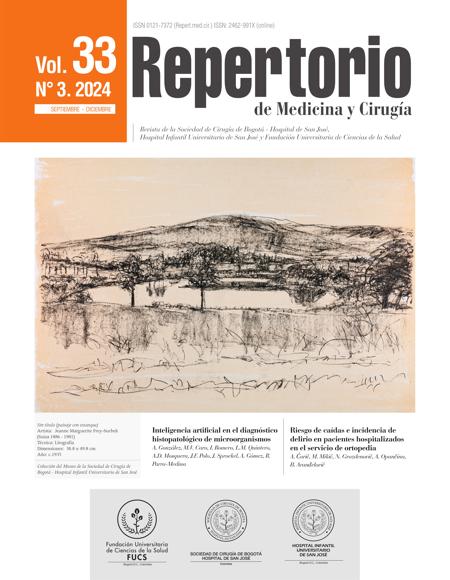Síndrome Dress por uso de Trimetropin Sulfametoxazol
Trimethroprim-Sulfamethoxazole-Induced Dress Syndrome
Esta obra está bajo una licencia internacional Creative Commons Atribución-NoComercial-CompartirIgual 4.0.
Mostrar biografía de los autores
El término DRESS se usó por primera vez en 1996 haciendo énfasis en una reacción a fármacos con eosinofilia y síntomas cutáneos y sistémicos. Está incluido en la triada de reacciones medicamentosas mortales con el exantema pustuloso generalizado agudo y el síndrome de Stevens Johnson/necrolisis epidérmica tóxica. En este reporte se presenta una reacción cutánea en paciente femenina en el Hospital de San José de Bogotá, en quien se diagnosticó síndrome DRESS por uso de trimetropim-sulfametoxazol, se discute la fisiopatología, diagnóstico, presentación clínica y tratamiento.
Visitas del artículo 2789 | Visitas PDF 1442
Descargas
- Callot V, Roujeau JC, Bagot M, Wechsler J, et al. Druginduced pseudolymphoma and hypersensitivity syndrome. Two different clinical entities. Arch Dermatol. 1996;132(11):1315–1321. DOI: https://doi.org/10.1001/archderm.1996.03890350057010
- Cacoub P, Musette P, Descamps V, Meyer O, Speirs C, Finzi L. The DRESS Syndrome: A Literature Review. Am J Med. 2011;124(7):588-97. doi: 10.1016/j.amjmed.2011.01.017
- Bellón T. Mechanisms of Severe Cutaneous Adverse Reactions: Recent Advances. Drug Saf. 2019;42(8):973-992. doi: 10.1007/s40264-019-00825-2 DOI: https://doi.org/10.1007/s40264-019-00825-2
- Choquet-Kastylevsky G, Intrator L, Chenal C, Bocquet H, Revuz J, Roujeau JC. Increased levels of interleukin 5 are associated with the generation of eosinophilia in drug-induced hypersensitivity syndrome. Br J Dermatol. 1998;139(6):1026-32. doi: 10.1046/j.1365-2133.1998.02559.x DOI: https://doi.org/10.1046/j.1365-2133.1998.02559.x
- Lonjou C, Thomas L, Borot N, et al. A marker for Stevens- Johnson syndrome: ethnicity matters. Pharmacogenomics J. 2006;6(4):265–268. doi: 10.1038/sj.tpj.6500356 DOI: https://doi.org/10.1038/sj.tpj.6500356
- Kano Y, Shiohara T. Sequential reactivation of herpesvirus in drug-induced hypersensitivity syndrome. Acta Derm Venereal. 2004;84(6):484–485. DOI: https://doi.org/10.1080/00015550410016976
- Quintero-Martínez DC, Flores-Arizmendi RA, Torres-Rodríguez L. Síndrome de DRESS asociado con carbamazepinaDRESS syndrome associated with carbamazepine. Bol Med Hosp Infant Mex. 2015;72(2):2-6. https://doi.org/10.1016/j.bmhimx.2015.03.007 DOI: https://doi.org/10.1016/j.bmhimx.2015.03.007
- Cacoub P, Musette P, Descamps V, Meyer O, Speirs C, el at. The DRESS syndrome: a literature review. Am J Med. 2011;124(7): 588-597. doi: 10.1016/j.amjmed.2011.01.017 DOI: https://doi.org/10.1016/j.amjmed.2011.01.017
- Husain Z, Reddy By, Schwartz RA. DRESS syndrome: Part 1 Clinical perspectives. Am Acad Dermatol 2013;68(5):693.e1-14. doi: 10.1016/j.jaad.2013.01.033 DOI: https://doi.org/10.1016/j.jaad.2013.01.033
- Peyriere H, Dereure O, Breton H, et al. Variability in the clinical pattern of cutaneous side-effects of drugs with systemic symptoms: does a DRESS syndrome really exist?. Br J Dermatol. 2006;155(2):422–428. doi: 10.1111/j.1365-2133.2006.07284.x DOI: https://doi.org/10.1111/j.1365-2133.2006.07284.x
- Shear NH, Spielberg SP. Anticonvulsant hypersensitivity syndrome. In vitro assessment of risk. J Clin Invest. 1988;82(6):1826-32. doi: 10.1172/JCI113798 DOI: https://doi.org/10.1172/JCI113798
- Cabrera H. Síndrome de hipersensibilidad a la sulfasalazina. Act Terap Dermatol. 2002;25:250.
- TICSE AGUIRRE, Ray et al. Síndrome de hipersensibilidad por uso de Trimetoprim/sulfametoxazol: Reporte de un caso. Rev Med Hered. 2006;17(2):109-114. DOI: https://doi.org/10.20453/rmh.v17i2.916
- Karpman E, Kurzrock EA. Adverse reactions of nitrofurantoin, trimethoprim and sulfamethoxazole in children. J Urol. 2004;172(2):448-453. doi: 10.1097/01.ju.0000130653.74548.d6 DOI: https://doi.org/10.1097/01.ju.0000130653.74548.d6













